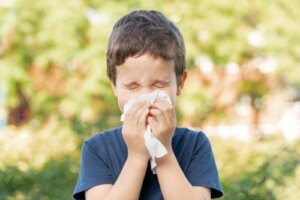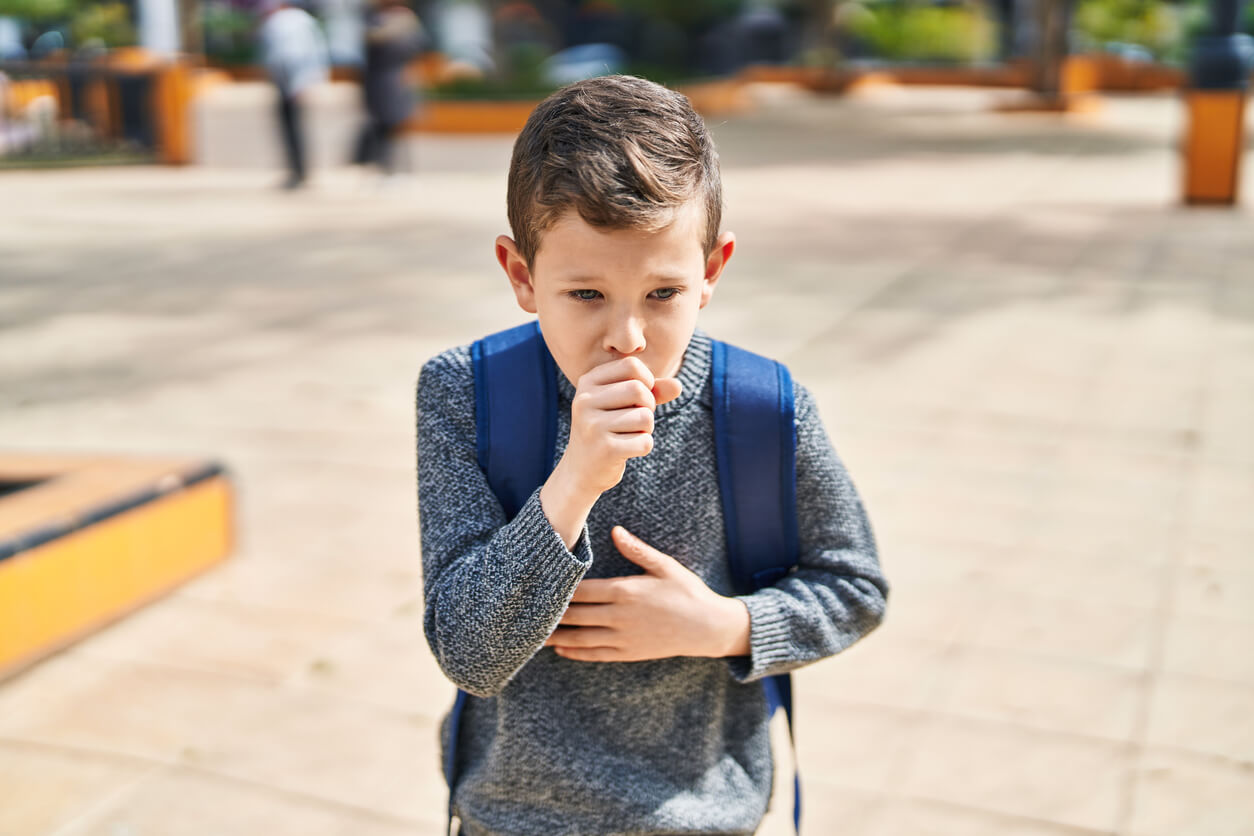10 Questions About Allergies in Children


Written and verified by the dermatologist Maria del Carmen Hernandez
In recent years, allergies in children have increased and currently affect about 35% of children. Although most of these manifestations are mild, there are often severe cases that require urgent medical attention. Parents tend to have a lot of doubts in this regard, which is why, in the following article, we want to answer the most frequently asked questions about allergies in children.
These are the most frequently asked questions about allergies in children
The prevalence of allergic manifestations in children has increased considerably in recent times due to lifestyle and environmental changes.
What are allergies?
An allergy is an exaggerated and abnormal response in the body when it comes into direct contact with an allergen that comes from the environment. This is a substance that’s usually common and harmless to other children, such as mold, pollen, dust mites, or animal dander.
Are allergies in children hereditary?
Although there’s a genetic predisposition, it’s exposure to irritant allergens, environmental allergens, and infections that determine sensitization to different inhalant and dietary allergens. Therefore, it’s important to implement early environmental and dietary control measures to reduce sensitization in order to detect and adequately manage the evolving symptoms.
When do allergies appear in children?
Although in most cases, the ability to develop an allergy is hereditary, the disease appears after sensitization to environmental and food allergens. In general, it’s triggered in childhood, when contact with various environmental substances and agents begins.
You may be interested in: Milk Allergy in Infants: What You Should Know

What are the signs and symptoms of allergies like?
The most frequent clinical manifestations are watery, red, edematous, or itchy eyes, which usually persist for more than a week. According to the American Academy of Pediatrics, allergic rhinitis (runny nose or itchy throat) is the most common type.
What diseases are related to allergies?
Atopic dermatitis, asthma, IgE-mediated food allergies, and rhinitis are often related conditions. In general, they may coexist or, as one condition improves, another may evolve.
Can you be allergic to any food?
Food allergic reactions fall into two general categories:
- Food allergy: The foods to which the child will be allergic depend on genetic predisposition and the time of exposure.
- Food intolerance: This is due to difficulty in digesting carbohydrates, especially lactose. Symptoms are therefore linked to the gastrointestinal tract (colic, bloating, and diarrhea).
In general, most food allergies are due to one or more of the following 8 foods: Milk, eggs, misery, nuts, fish, shellfish, soy, and wheat.
Can there be complications of allergies in children?
Anaphylaxis is an acute, severe allergic reaction that tends to involve two or more organs. After exposure to the triggering factor, the reaction occurs within minutes or hours. It may even begin with skin erythema and urticaria, which rapidly progress to cardiac and respiratory involvement.
Read also: Skin Rashes on Babies: What You Should Know
How is an allergy diagnosed?
There are different methods of diagnosing allergic disease. A blood test can detect immunoglobulin E specific to the allergen suspected to be the causative agent.

What treatment is available for allergies in children?
Management of the symptoms and signs of skin, intestinal, or respiratory allergies may require antihistamines or other medication. According to the World Health Organization, the only treatment capable of modifying the natural and evolutionary process is vaccination or immunotherapy.
What measures can be taken to prevent them?
Finally, one of the most frequent questions about allergies in children is how to prevent them. Environmental control measures are the most important in the management of respiratory allergies. Therefore, environmental irritants such as cigarette smoke should be avoided. According to recommendations of the American College of Allergy, Asthma & Immunology, dust mite avoidance measures consist of eliminating dust and moisture. Therefore, pillows and mattresses should be covered with waterproof covers.
Final considerations of allergies in children
Allergies in children are the consequence of the interaction between environmental and genetic factors in the manifestation of the disease. Currently, the best management for children who are at high risk is to implement environmental and dietary control measures early to avoid or postpone the evolution.
In recent years, allergies in children have increased and currently affect about 35% of children. Although most of these manifestations are mild, there are often severe cases that require urgent medical attention. Parents tend to have a lot of doubts in this regard, which is why, in the following article, we want to answer the most frequently asked questions about allergies in children.
These are the most frequently asked questions about allergies in children
The prevalence of allergic manifestations in children has increased considerably in recent times due to lifestyle and environmental changes.
What are allergies?
An allergy is an exaggerated and abnormal response in the body when it comes into direct contact with an allergen that comes from the environment. This is a substance that’s usually common and harmless to other children, such as mold, pollen, dust mites, or animal dander.
Are allergies in children hereditary?
Although there’s a genetic predisposition, it’s exposure to irritant allergens, environmental allergens, and infections that determine sensitization to different inhalant and dietary allergens. Therefore, it’s important to implement early environmental and dietary control measures to reduce sensitization in order to detect and adequately manage the evolving symptoms.
When do allergies appear in children?
Although in most cases, the ability to develop an allergy is hereditary, the disease appears after sensitization to environmental and food allergens. In general, it’s triggered in childhood, when contact with various environmental substances and agents begins.
You may be interested in: Milk Allergy in Infants: What You Should Know

What are the signs and symptoms of allergies like?
The most frequent clinical manifestations are watery, red, edematous, or itchy eyes, which usually persist for more than a week. According to the American Academy of Pediatrics, allergic rhinitis (runny nose or itchy throat) is the most common type.
What diseases are related to allergies?
Atopic dermatitis, asthma, IgE-mediated food allergies, and rhinitis are often related conditions. In general, they may coexist or, as one condition improves, another may evolve.
Can you be allergic to any food?
Food allergic reactions fall into two general categories:
- Food allergy: The foods to which the child will be allergic depend on genetic predisposition and the time of exposure.
- Food intolerance: This is due to difficulty in digesting carbohydrates, especially lactose. Symptoms are therefore linked to the gastrointestinal tract (colic, bloating, and diarrhea).
In general, most food allergies are due to one or more of the following 8 foods: Milk, eggs, misery, nuts, fish, shellfish, soy, and wheat.
Can there be complications of allergies in children?
Anaphylaxis is an acute, severe allergic reaction that tends to involve two or more organs. After exposure to the triggering factor, the reaction occurs within minutes or hours. It may even begin with skin erythema and urticaria, which rapidly progress to cardiac and respiratory involvement.
Read also: Skin Rashes on Babies: What You Should Know
How is an allergy diagnosed?
There are different methods of diagnosing allergic disease. A blood test can detect immunoglobulin E specific to the allergen suspected to be the causative agent.

What treatment is available for allergies in children?
Management of the symptoms and signs of skin, intestinal, or respiratory allergies may require antihistamines or other medication. According to the World Health Organization, the only treatment capable of modifying the natural and evolutionary process is vaccination or immunotherapy.
What measures can be taken to prevent them?
Finally, one of the most frequent questions about allergies in children is how to prevent them. Environmental control measures are the most important in the management of respiratory allergies. Therefore, environmental irritants such as cigarette smoke should be avoided. According to recommendations of the American College of Allergy, Asthma & Immunology, dust mite avoidance measures consist of eliminating dust and moisture. Therefore, pillows and mattresses should be covered with waterproof covers.
Final considerations of allergies in children
Allergies in children are the consequence of the interaction between environmental and genetic factors in the manifestation of the disease. Currently, the best management for children who are at high risk is to implement environmental and dietary control measures early to avoid or postpone the evolution.
All cited sources were thoroughly reviewed by our team to ensure their quality, reliability, currency, and validity. The bibliography of this article was considered reliable and of academic or scientific accuracy.
- A R, Baranwal AK. Child with Allergies or Allergic Reactions. Indian J Pediatr. 2018 Jan;85(1):60-65. doi: 10.1007/s12098-017-2436-8. Epub 2017 Sep 11. PMID: 28890990.
- Lee SE, Kim H. Update on Early Nutrition and Food Allergy in Children. Yonsei Med J. 2016 May;57(3):542-8. doi: 10.3349/ymj.2016.57.3.542. PMID: 26996550; PMCID: PMC4800340.
- Ward CE, Greenhawt MJ. Treatment of allergic reactions and quality of life among caregivers of food-allergic children. Ann Allergy Asthma Immunol. 2015 Apr;114(4):312-318.e2. doi: 10.1016/j.anai.2014.12.022. Epub 2015 Feb 7. PMID: 25660416.
This text is provided for informational purposes only and does not replace consultation with a professional. If in doubt, consult your specialist.








